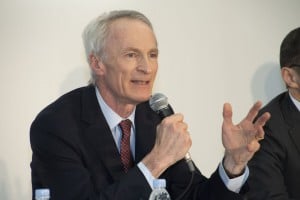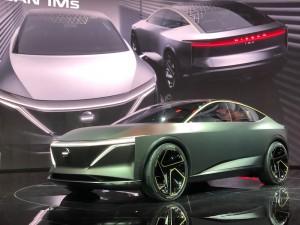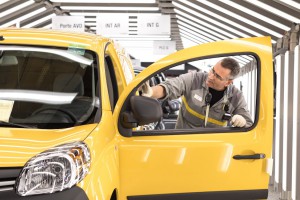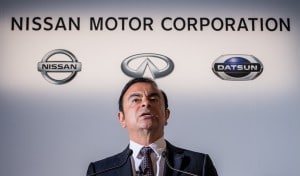
Renault Chairman Jean Dominique Senard, who also serves as the Alliance chief, laid out an optimistic forecast for the future – though the group is no longer pushing to be the global auto sales leader.
After months of decline, shares of the three automakers forming the Renault-Nissan-Mitsubishi Alliance surged sharply on global exchanges Wednesday.
Shareholders signaled their satisfaction with plans to save the long-running partnership that had been teetering on collapse since the controversial arrest of former Alliance boss Carlos Ghosn in November 2018. At a closely watched joint conference on Tuesday, the partners announced plans to cooperate more closely than ever – but they also ruled out further talk about a formal merger of Renault and Nissan.
By commonizing product development and adopting a “leader-follower strategy,” the three companies are expecting not only to save billions of dollars annually but also get better products to market faster than before.
(Nissan may cut 20K jobs globally; Renault could go under, French minister warns.)
“In a few years’ time, given what we’re doing now, this alliance is going to be the most powerful combination of companies in the world,” Alliance Operating Board Chairman Jean-Dominique Senard, who also serves as Renault chairman, said in a joint news conference. The steps outlined by the three automakers, he added, are absolutely essential.”
Renault and Nissan first joined forces two decades ago when the French automaker announced a bailout of the then-faltering Japanese automaker. Mitsubishi was added to the Alliance after Nissan acquired a controlling stake in the smaller company in 2016.
For years, Ghosn and other officials routinely bragged about the synergies the Alliance was delivering. By late in the last decade, meanwhile, combined sales grew to the point that the Renault-Nissan-Mitsubishi Alliance rivaled traditional industry leaders Toyota and Volkswagen, surging past General Motors.
But the arrest of Ghosn – who was subsequently accused of a series of financial crimes – revealed what was really a partnership in name more than reality, according to many observers. And it came close to breaking up the Alliance. Compounding matters, all three companies were found to be suffering serious financial problems of their own, Nissan suffering its first full-year loss in 11 years and the French government warning Renault could fail without taking some drastic steps.
The complex mix of moves announced this week aim to shore up each company individually by forming a tighter and more effective Alliance, the partners agreed. But one of Renault’s long-running goals is no longer on the table.
“We do not need a merger to be efficient,” said Senard.

Nissan will largely lead future EV development within the Alliance, though Mitsubishi will oversee PHEVs.
The partners broke with the approach taken by Ghosn who was fond of setting detailed numerical targets that pushed the limits in terms of sales, margins and profits. Critics have suggested that these strategies often resulted in short-term gains favored by investors, but led to long-term problems, such as cost-cutting efforts that left the companies without competitive products.
(Nissan plans for restructuring call for $2.8B in cost cuts.)
Underlying issues, meanwhile, were not addressed. Despite claiming to share underlying platforms, for example, there was far less commonization than needed, the partners now agree. In 2019, for example, only 39% of the vehicles produced by the three manufacturers were based on shared architectures. By 2024, said Senard, that will double.
That is expected to save about 2 billion euros, or $2.2 billion, just on the development of the next generation of compact crossovers for the three manufacturers.
But what is key to making the Alliance finally reach its promise, officials said, is what is being described as a “leader-follower strategy” that will have each manufacturer take responsibility for specifics aspects of the business, as well as geographic “reference regions.”

Renault – one of its French plants shown here – will lead in several key “reference regions,” including Europe, Russia and South America.
Nissan, for example, will be the lead when it comes to most aspects of the joint electrification effort, as well as autonomous driving. Mitsubishi will carve out work on plug-in hybrids, with Renault tackling battery technology for small vehicles.
Nissan, the largest of the three manufacturers by sales, will be lead in China, North America and Japan, Renault overseeing the European, Russian, South American and North African markets. Mitsubishi, meanwhile, will oversee operations in Southeast Asia and Ocenia.
While the three partners are betting the new strategy will make them far more profitable going forward, they have also scaled back ambitions, at least from a sales standpoint. At its 2017 peak, the Alliance racked up global demand for 10.61 million vehicles, surging past both Toyota and Volkswagen. But sales have plunged since then, and the partners are set to scale back the win-at-all-cost approach going forward.
(Renault-Nissan-Mitusbishi Alliance expected to announce plan next week.)
All three manufacturers scored with investors following the announcement of the new strategy, Renault shares climbing as much as 16% on Wednesday, Nissan and Mitsubishi both up more than 5%. Meanwhile, stockholders drove up shares of Daimler AG by around 10%. The German automaker has developed a close relationship with the Alliance over the past decade, though it is not a formal partner. Senard said he hopes to expand ties to Daimler going forward, with an announcement of additional plans set to come in the next few weeks.

